Knowing how to store a guitar is essential to keeping it in its best condition. Improper storage of a guitar can lead to damage, discoloration, and potentially breakages.
As a guitar player for over 15 years, I’ve written this guide to give you all the tips you need to store your guitar safely, and keep it in great condition for years to come.
Affiliate disclaimer: This page contains affiliate links for products that I’ve tried and tested. As an Amazon Associate I earn from qualifying purchases at no additional cost to you. Learn more here.
How to store your guitar
Whether you’re storing a guitar between practice, or putting it away for a few months, you’ll want to know that it’s safe. Here’s my tried and tested tips for how to store your guitar, and keep it safe.
Your guitar is safest in a hard case
Hard cases are without a doubt the best way to store your guitar. The hard shelled design protects your guitar from damage caused by bumps, knocks, and falls.
Not only this, but it keeps your guitar safely away from the harmful effects of direct sunlight and dust, but more on these later. Hard cases also act as a buffer against sudden changes to temperature and humidity, slowing the negative effects – but not completely preventing them. Again, more on these effects later.

This doesn’t mean that a hard case is the only way you should store your guitar, but it’s definitely the gold standard for guitar storage. Any case, like a padded gig bag, will help keep your guitar protected against the elements.
But, a soft case won’t do much to protect it from impact damage. So, a hard case is essential for long term storage, transporting, or shipping.
Don’t stack your guitar cases on top of each other
Even though your guitar is safest in a case, stacking them on top of each other is bad – even with hard cases. The weight can deform the cases towards the bottom of the stack. This can put pressure on the guitar’s neck, which can cause it to deform over time.
Store your guitars next to each other, like books on a shelf. They shouldn’t be stacked on top of each other like pancakes.
To keep your guitar’s upright, they need to be properly supported. Otherwise, they may fall down. Storing your guitars in their case and on a rack is the best way to keep them organized and secure.
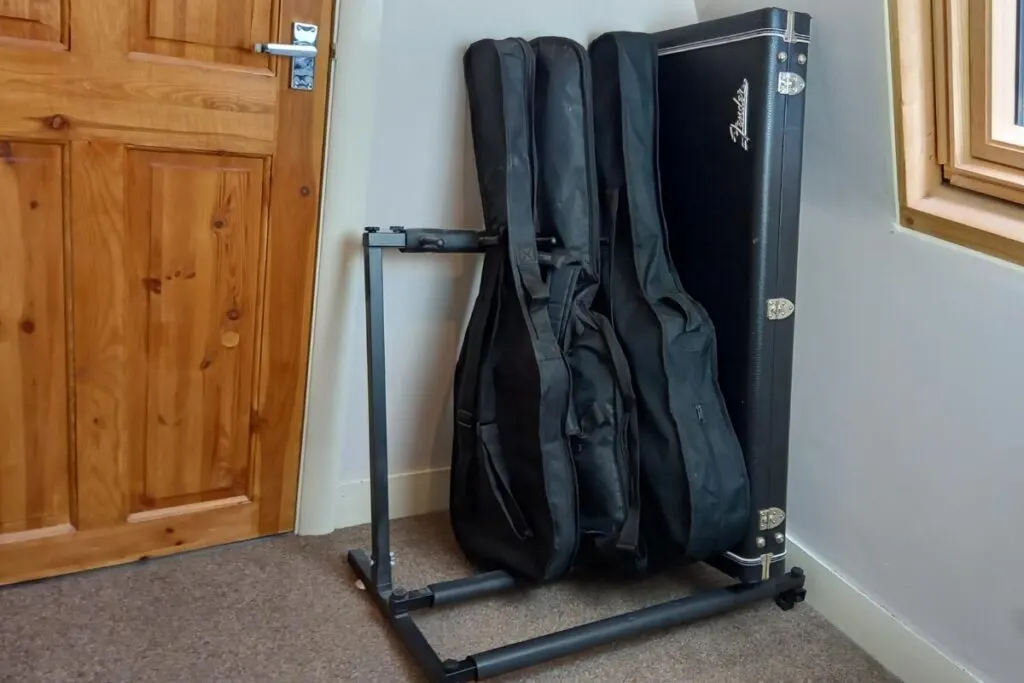
Beware of temperature and humidity changes
Guitars are made of wood, which means that they are affected by changes in temperature and humidity levels. These changes can cause your guitar to expand and contract, which can damage your guitar’s finish. In extreme cases, it can also damage your guitar’s components and neck.
To avoid this, make sure that your guitar is stored in a room with a stable humidity and temperature.
- The optimal guitar storage temperature is between 66-77 °F
- The humidity should be keep between 45 – 55%
Rooms like attics, basements, and garages are all subject to dramatic temperature and humidity changes, so you shouldn’t store your guitar in them.
Likewise, rooms with external walls (walls with one side that’s on the outside world) have the biggest temperature changes. So, it’s best to keep your guitar in a room without any external walls where possible. If, like me, all your rooms have at least one external wall – then keep your guitars away from that wall.
If you don’t have a lot of space, then try to control the temperature in the room by heating and cooling it. Likewise, you can control the humidity with a humidifier and dehumidifier.
Sunlight can damage your guitar’s finish
Heat and humidity isn’t your guitar’s only problem. Direct sunlight is another factor that can damage a guitar’s finish. The ultra-violet radiation from the sun’s rays can bleach the paint. This is usually most obvious on guitar’s with a lighter colored finish, but it will happen to all of them over time.
Also: direct sunlight usually means heat. So, it’s best to keep your guitar out of it anyway.
Keep it on a stand or hanger that’s away from a window and out of the path of direct sunlight. If that’s not possible then using a case will protect it from the effects of sun damage – just be wary of the heat!
Don’t lean your guitar against anything
Leaning your guitar against a wall or chair might be convenient, but it’s very dangerous for your guitar. Even for a short amount of time. The slightest movement can make your guitar slide and fall – and falls usually mean damage.
I’ve actually seen this happen in front of me. A friend of mine had their acoustic guitar leaned against a chair, and it slipped while we were talking. When it hit the ground, the headstock snapped off. The damage was too expensive to repair, so the guitar had to be thrown away.
Likewise, you shouldn’t leave your guitar laying around on the floor. This can put excess pressure on the neck, which can affect its calibration over time. Not only this, but it also increases that risk that it will be stepped on, which can severely damage the guitar.
If you’re putting your guitar down for a moment, make sure to put it back in a stand. It’s worth the few extra seconds to keep it safe.
Put your guitar out of harm’s way
If you have pets, children, or live in a busy home – your guitar is at risk of being knocked over. The best way to avoid this is to store your guitar away from high traffic areas.
If possible, keep your guitars in a secure room that isn’t used by everyone. I’ve set up a small space in a spare room that’s away from the main footfall of my house.
If this isn’t an option for you, then your guitar is safest in the corner of a room, as it’s much less likely to get knocked over.
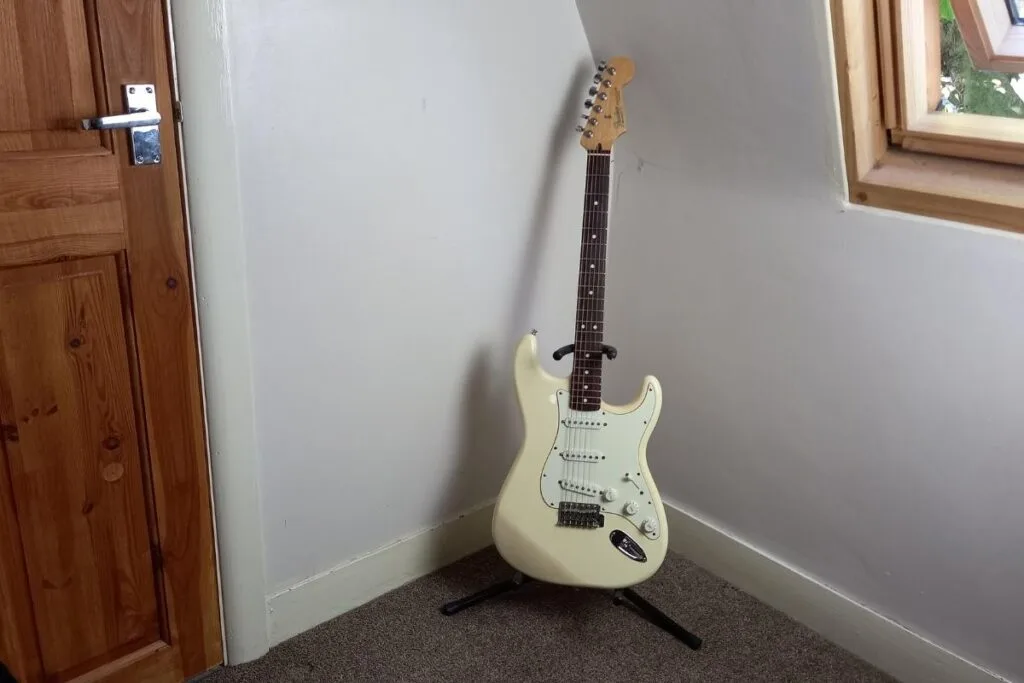
To be extra safe, I always recommend using a guitar stand that has neck support. Better yet, get a wall hanger to keep it off the floor completely.
Keep the strings tight
Your guitar’s neck is designed to counter the constant pressure from the tension of the guitar strings. You might think that relaxing or removing the strings during longer-term storage gives the neck a rest, but it actually needs this tension.
If the strings are too loose, or removed, the truss-rod can pull the neck back over time, causing it to become misaligned or misshapen. This will most likely result in some fret buzz when you start playing again.
However, acoustic guitars with nylon strings will need the strings relaxing, slightly. They should be tuned down by two steps during longer term storage (anything over a few months). This is because nylon tightens over time, On “in tune” strings, this could increase the string tension over what it should be. Electric guitar strings don’t have this problem, so leaving them in tune is okay.
Dust can damage your guitar’s electronics
Dust is not only unsightly, but it can also damage your guitar. The small particles can work their way inside your guitar’s cavities and cause disruption to the delicate electronics.
The best way to protect against this is to store your guitar in a case to protect it. Even if a simple gig bag will keep it safe from dust.
Also, make sure to keep the space your guitar is in clean. This is especially true if you’re sharing a space with pets – fur is just as bad as dust! Not only will it keep your guitar safer, but a clean space is also much more enjoyable to play in!
Some foam stands can damage your guitar
Most guitar stands use some type of foam padding to protect your guitar from the metal frame. But, this foam can damage the guitar’s finish in the longer term.
Over time, the foam releases gases that can react with any paint that’s in contact – especially nitrocellulose paint. The result, often called “nitro burn”, is an unsightly stain that’s very difficult to remove.
If you’re pickup up your guitar and playing it every day, it won’t be a problem. But for longer period storage, the risk increases. In this case, I recommend storing your guitar in a case to keep your guitar out of contact with the foam.
If that’s not possible, then I recommend using a guitar stand with a nitrocellulose safe finish, like those made by Hercules. You can check out their range here on Amazon. I have a Hercules GSP38WB wall hanger installed for my Stratocaster.
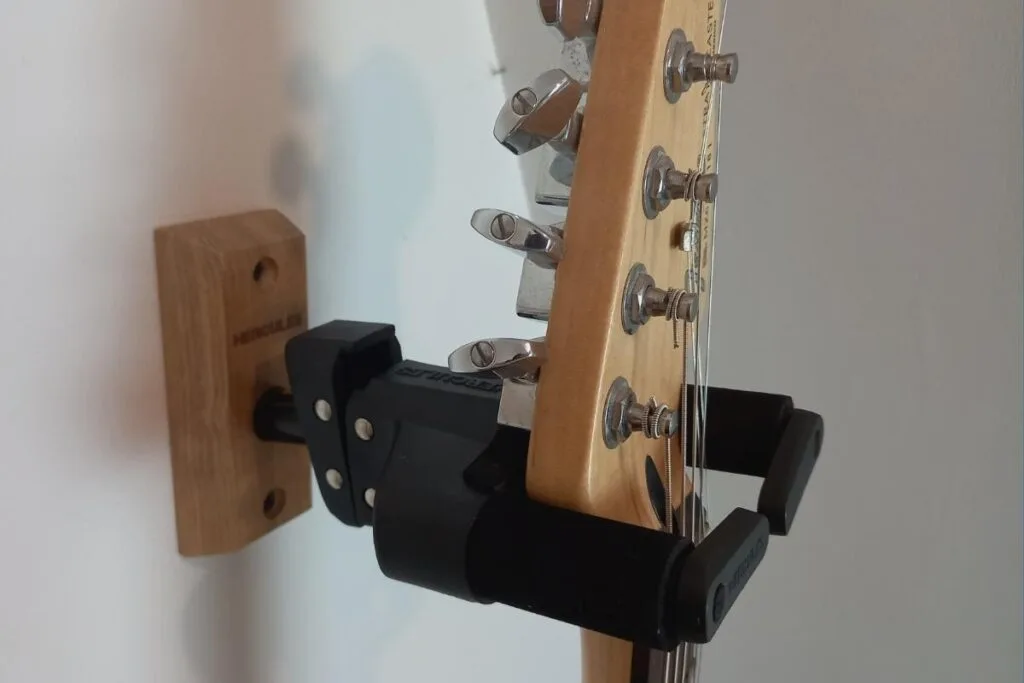
Storing a guitar between uses
If you’re using your guitar regularly, then you’ll want to keep it accessible and ready to pick up and play. Here are some tips:
- Keep it in a stable place: Whether it’s a stand or wall-hanger, just make sure that it’s stationary and stays stationary. Leaning it against your amp or a chair isn’t stable, it’s not good for the neck, and it’ll fall sooner or later.
- Keep it in a case: Hard cases or the gold-standard for protecting your guitar, but even a gig bag will protect against the effects of dust and sunlight. A case will also keep your guitar from reacting with the foam on your stand (if it’s not a guitar-finish safe foam)
- Put it in a low traffic area: The corner of your room is the best place for keeping your guitar. It’s much less likely to get accidentally knocked.
If you’re like me and are storing your guitars in a small room, I recommend hanging your guitar on the wall using a wall-mount.
I recommend the Hercules GSP38WB, as it has an auto-locking system that further protects your guitar. It also has a special material that is safe for nitrocellulose finishes, so it won’t damage your neck. Check out the latest price here on Amazon.
I written a guide on whether wall-hangers are bad for guitars, as well a guide on how to install them.
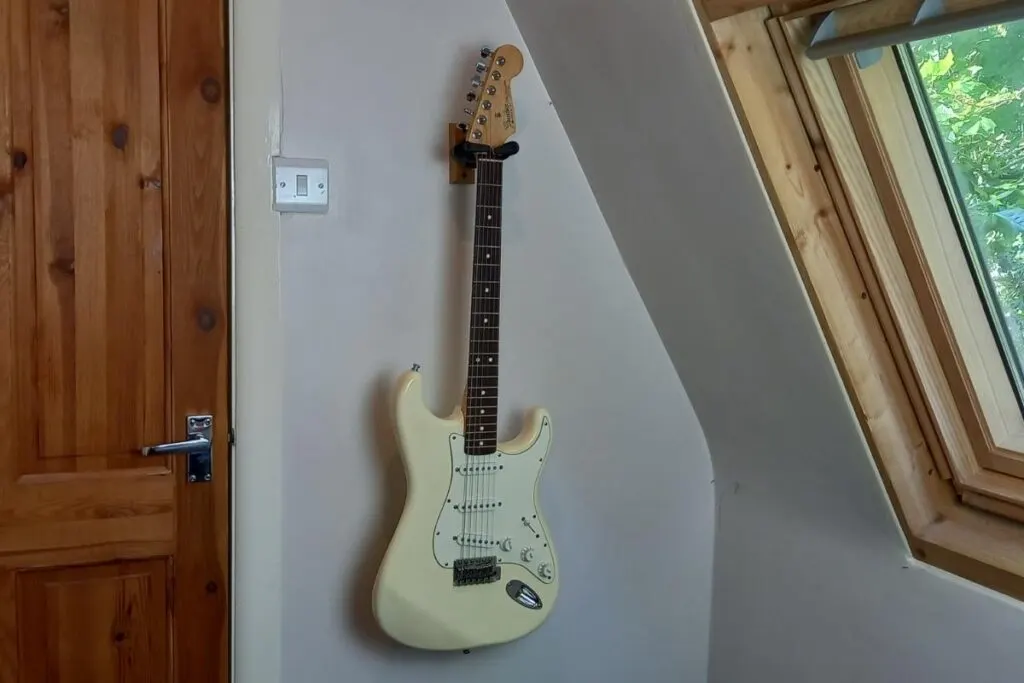
Alternatively, you can use a guitar rack, but I’ve found these to be bulky and take up a lot of floor space. Wall mounting your guitar, especially if you have more than one, is a very space effective way to store them.
If you’re using a floor stand, make sure it has neck support as opposed to a simple “A” frame stand. The neck support will keep your guitar more secure and safer from falling over. I recommend the Hercules GS414B stand. Check it out here on Amazon.
Storing a guitar long term
When it comes to storing a guitar long term, like for a few months or even years, you’ll want to take some steps to make sure it’s completely protected.
Here’s how to keep your guitar safe for long term storage:
- Store it in a hard case: A hard case is a must for longer term storage. It provides superior protection against physical damage, including the effects of and dust. It also provides a good buffer against the effects of humidity, meaning it shouldn’t be as effected by rapid changes. You can also get specialised humidifiers that are put into your case, if it’s placed in an area with low humidity
- Store in it a temperature and humidity controlled room: Keep your guitar out of places that have large variances in temperature. The best place is a room away from external walls, that isn’t too high (like the attic) or too low (like the basement). If you’re putting it into a storage facility, look at how the containers are set up. Are they inside or outside? Ask the people about temperature.
- Keep it in tune: For electric guitars, I recommend keeping the guitar in tune. This will keep the string tension on the neck and stop it from bowing. For acoustic guitars with nylon strings, loosen the strings by a couple of steps – as they can contract over time.
- Check on it every so often: Be sure to check on your guitar every few months to make sure that it’s still in good condition.
Related questions
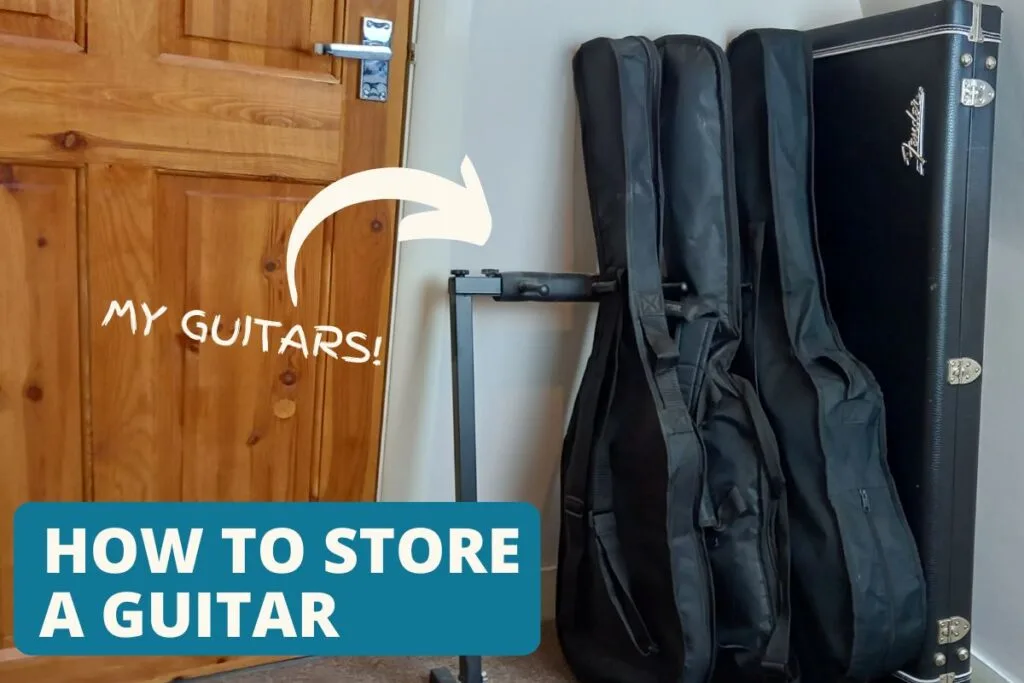

Conor is a music producer, multi-instrumentalist, and all-round enthusiast from the UK with over 15 years of experience. He’s the founder and sole-content creator for the roundtable audio blog and YouTube channel.
